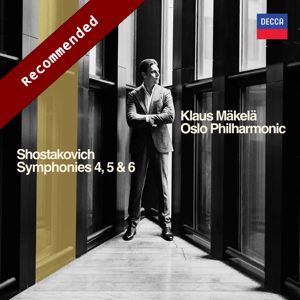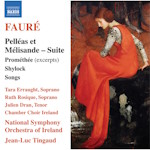
Dmitri Shostakovich (1906-1975)
Symphony No. 4 in C minor, Op 43 (1935-6)
Symphony No. 5 in D minor, Op 47 (1937)
Symphony No. 6 in B minor, Op 54 (1939)
Oslo Philharmonic/Klaus Mäkelä
rec. 2022/2023, Konserthus, Oslo, Norway
Decca 485 4637 [2 CDs: 145]
I should put my cards on the table, and declare from the outset that these recordings blew my mind! Having said that, I would not wish to duplicate anything with which John Quinn has already enlightened us in his excellent review. However, having myself spent a lifetime studying, performing, and writing about Shostakovich’s string quartets, I may be able to contribute here a few words from a player’s perspective; and in doing so hope very much that Klaus Mäkelä would not think it presumptuous of me to recognise a kindred spirit – in that I find in these performances an approach to this music with which I feel decidedly at one. Having a few weeks ago listened to the entire album straight through I have since returned to it, armed with scores – but heard this time in reverse chronological order: meaning that it was the final pages of No.4 that were freshest in my mind. What totally unbelievable music! I find it almost impossible to believe that I actually knew this genius of a man, corresponded with him, and played to him myself. It was life changing; and affected, influenced, coloured everything I have done as a musician in the intervening 52 years. So, I know I must tread warily when listening to others perform his music – not least when required to express opinions.
The Fourth has, of course, earned for itself quite a reputation – dating as it does from one of the most turbulent periods of his life. Yet, for the first four months of its composition, Shostakovich was at the height of his fame thus far, thanks to the enormous success of his new opera Lady Macbeth of the Mtsensk District. As John Quinn perceptively points out (tacitly agreeing with that other fine writer, Hugh Ottaway), this proved by far the most ambitious and advanced of his first four symphonies, and his current renown must have afforded him extra confidence in returning to symphonic writing after six years. What strikes me, on listening to Mäkelä’s deeply insightful realisation of the work, is that No.4 is as operatic as it is symphonic; but also, conversely, surprisingly prophetic of his upcoming immersion in chamber music: regrettably, we quartet players have nothing from these times to play! And although Quartet No.1 was written between the two symphonies on the second CD of this set, it turned out to be what the composer himself described as “a Springtime work”: gentle, brief, unassuming – maybe a much-needed recourse to inner relaxation after the tumult of the preceding couple of years. It seems to me that Mäkelä’s vision of the Fourth does indeed embrace both opera and chamber music: he does not shirk from the massive drama of its two outer movements, yet still allowing the music to sing as much as it confronts. Even the very opening – as shrill as it demands to be – is immediately contrasted by brass playing which delivers a sonorous depth of sound, rather than outright brazen-ness. And before long we have heard some delicate ensemble playing from the double reeds, followed by expressively lyrical strings: an early exposition of the exceptional quality of this orchestra, and its various soloists.
There is also Mäkelä’s – together with the orchestra’s – commendable attention to the details within this massive score: not least with regard to tempo and dynamics. For we quartet players, this is a given prerequisite; but for larger forces, far more difficult to realise – to a degree that the listener can so readily hear in these performances. It is not just that “hairpin” crescendi and diminuendi are accurately observed; more that they are underpinned by an appropriate intensification/de-intensification of sound and movement, which communicates to the listener that much more vividly. Indeed, without exception the array of wonderful soloists in this orchestra (not forgetting the string principals) deliver their key moments with a variety and flexibility of colour that draws one ever deeper into this astonishing music – not least the big trombone solo in the third movement, which comes over in the manner of a great operatic aria. And I have rarely heard bassoon playing of such expressive sincerity – an instrument which this composer used with unmistakable individuality and prominence: listen to the opening of the third movement, and marvel at how the melody achieves a heightened poignancy through subtle variations of vibrato and tone colour.
No less praiseworthy is the conductor’s adherence and respect for the composer’s instructions with regard to tempo – specifically his metronome marks: Johann Mälzel’s ever-controversial machine can incite the most extreme polarisation of opinion, which is not always resolved by Shostakovich’s treatment of them in some of his own performances. John Quinn praises a number of Mäkelä’s specific tempo choices – and it is reassuring to find that nearly all of those are what the composer actually notated! Yet he is too fine a musician to be straitjacketed by numbers on a page: maybe well aware of Beethoven’s own stated implication that his markings must indeed be observed – but necessarily apply only to the first bar! True to form, this conductor appears to treat them just so, as little more than a starting point. It is understandable that there are certain instances – especially with slower music – where one needs to be somewhat judicious (for example, we in the Fitzwilliam String Quartet deduced that for many of his Adagios at 80 beats to the minute, Shostakovich was invariably hearing 69!). This is particularly relevant in the slow march which opens the finale – where the conductor rightly recognises the huge influence of Mahler (a picture of whom was prominent on Shostakovich’s big desk in the Moscow House of Composers): at a couple of notches below what is notated, one could be forgiven for believing this music to be by Mahler himself!
I appear to have left scant space for the other two symphonies in this collection; but maybe readers will agree that the Fourth is that much less familiar – and accessible – than its two successors. Indeed, the Fifth is undoubtedly the most performed of the entire cycle, and John Quinn’s remarks in his review strike me as entirely apt. This performance not only enables us to hear the work in a new light; but demonstrates that there is nothing “new” at all, insofar as we are treated to a truly faithful rendition of what is actually on the page – further enhanced by a profound grasp of the content and context of the musical message it carries. Mäkelä is not afraid to set off at what might appear to some as a deliberate tempo – in fact, he is exactly on the clock; but as the first subject material unfolds he sensitively allows more flow to underpin that unfolding. He then finds the right relationship with the serene and enchanting second subject – a moment which has seen all manner of attempted solutions over the years, when all one has to do is be faithful to what it says in the score! Similarly, the next movement is rollicking and steady: whatever comparison with the corresponding section of Mahler’s First might be made here, they don’t necessarily work at the same speed as each other. The one risk he doesn’t quite allow himself is with the even more controversial coda of the finale: I wish he had dared to go even slower (as marked). It so happens Maxim Shostakovich didn’t either! My USSR Melodiya LP has a touching photo of father and son in profile on its sleeve, so we can assume the composer was at the sessions – and approved. It would be no surprise to hear that Mäkelä had himself checked in on this performance – and maybe he had tried it slower in rehearsal, and found the same slight compromise proved more effective.
There is some truly ravishing pp and ppp playing in this symphony – indeed, in all three of them: not least during the extraordinary opening Largo of No.6 – which the conductor regards as “the finest single symphonic movement Shostakovich ever wrote”. And this performance does full justice to his opinion, in every respect. Within its pages we find passages which acknowledge a rather different aspect of Mahler: for example, those dangerously spare, haunted passages in his Ninth and Tenth symphonies: so still that one hardly dare breath. Yes, the two short, fast movements which follow can create for this symphony an odd, almost schizophrenic impression; yet it could be that the little string quartet (No.1) which Shostakovich composed during the intervening year between the composition of the Fifth and Sixth symphonies might have proved rather more significant than it is usually credited with: the aforementioned two quick movements are actually marked to be played at exactly the same tempo as their predecessors in the quartet! And both afford great opportunity for the players to revel in their own – and each others’ – virtuosity. Yet, with the Oslo Philharmonic, there is rather more to their instrumental skills than sheer display: we know from his letters – and from those of us who knew him – that Shostakovich was not always so serious as the reputation that has largely come down to us. He loved to laugh, joke, have fun; and I can think of no pieces which demonstrate this more winningly than the finales of Quartet 1 and Symphony 6: the latter absolutely ends in a riot – and this performance goes for it in full, yet with none of that bombast which can so easily cheapen its hard-won exhilaration. One final thought: with what inward glee must Dmitri Dmitrievich have lifted the key of B minor – which carried such significance for the likes of J S Bach, Schubert, Liszt, Tchaikovsky – from the depths of seriousness to the outrageous abandon he gifts us here!
These performances are so compellingly truthful that I for one hope that Klaus Mäkelä will give us what for this writer is the most special of all: No.15. We read that it is programmed in Norway this Spring.
Alan George
Previous review: John Quinn (September 2024 Recording of the Month)
Buying this recording via a link below generates revenue for MWI, which helps the site remain free



















